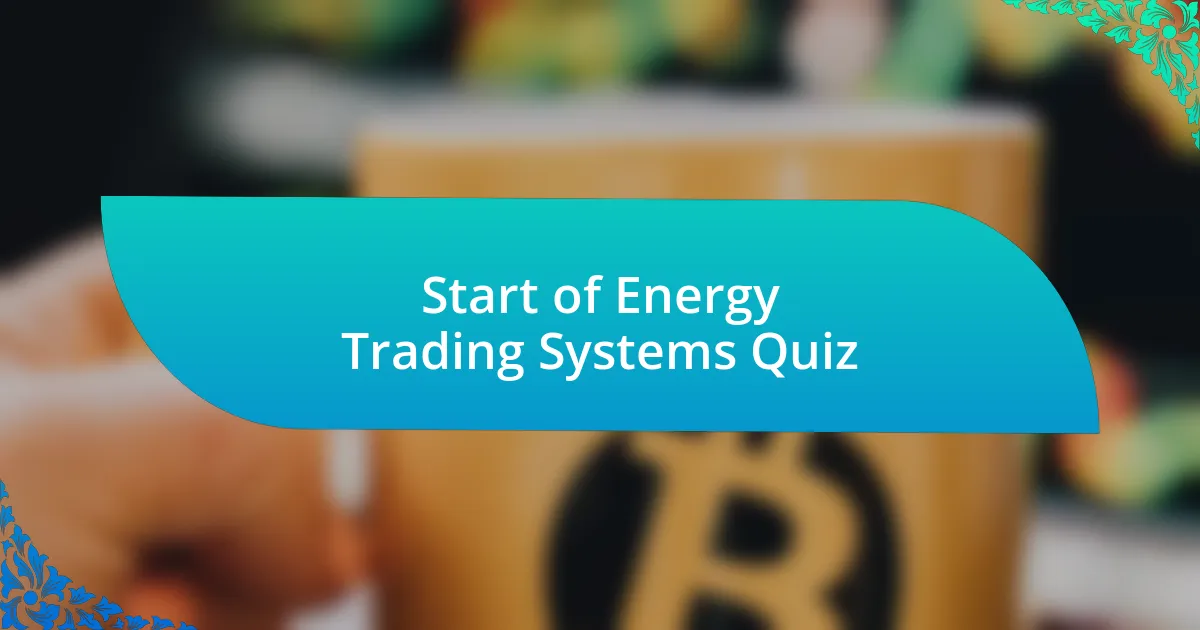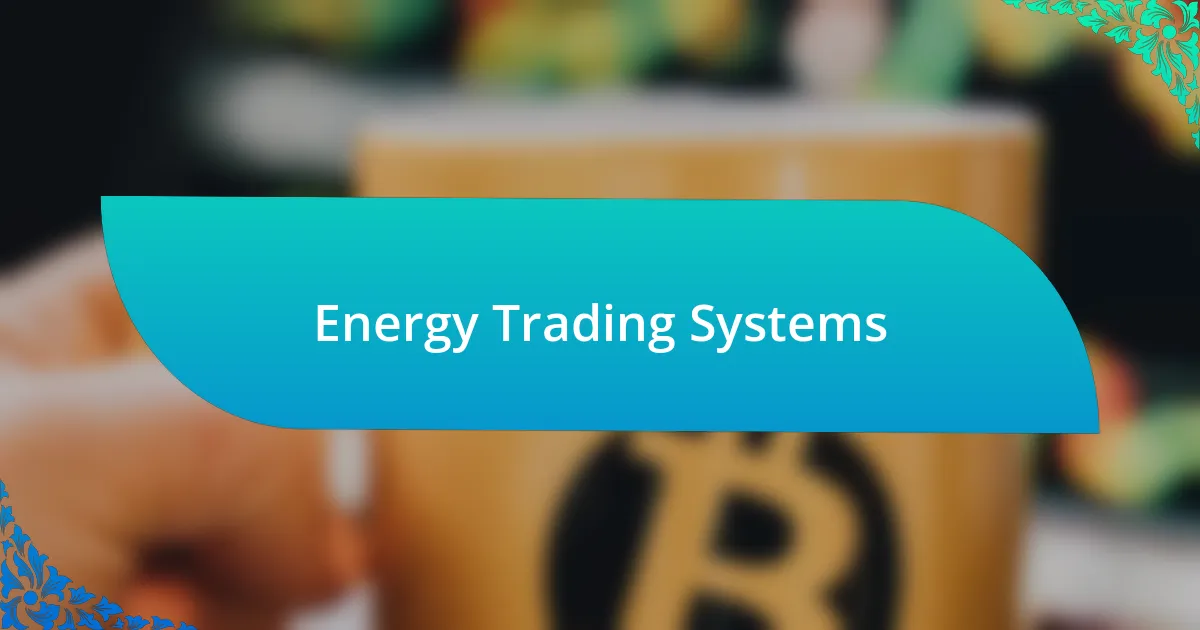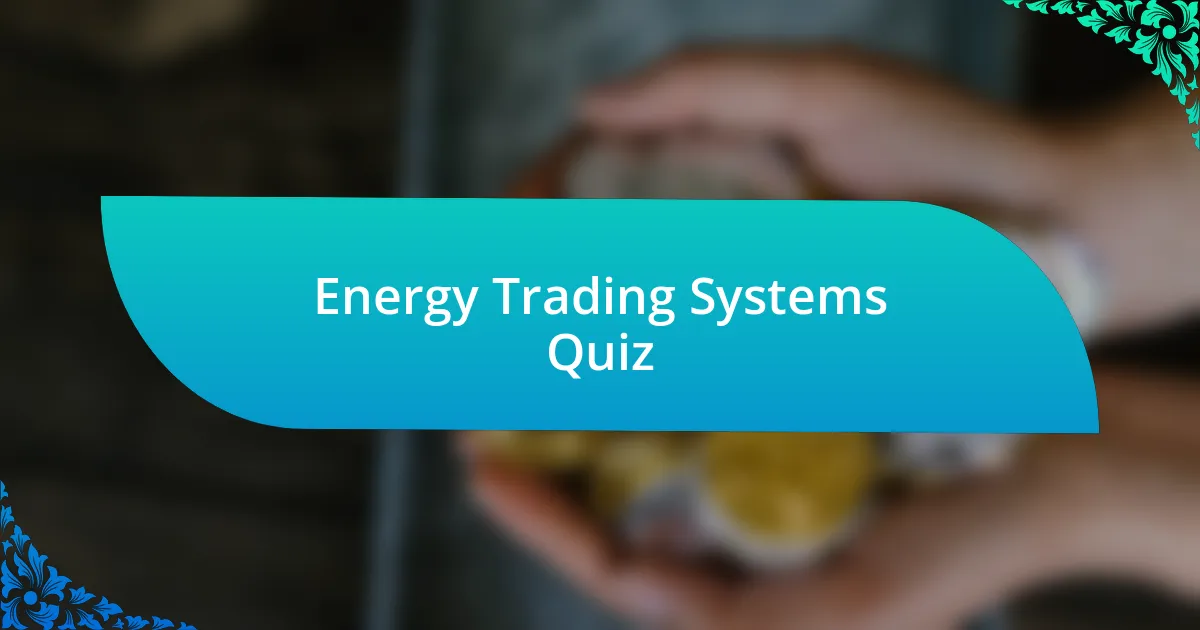
Start of Energy Trading Systems Quiz
1. What key advantage do Ethereum-based energy trading systems provide over traditional systems?
- Decentralization of trading processes
- Limited market access
- Increased fossil fuel usage
- Higher transaction fees
2. How do Ethereum smart contracts facilitate energy trading?
- Managing fossil fuel markets efficiently.
- Automating peer-to-peer energy transactions.
- Providing traditional billing methods for consumers.
- Facilitating government regulations on energy use.
3. In what ways can Ethereum enhance transparency in energy trading transactions?
- Limiting energy access to only large companies and utilities.
- Leveraging smart contracts for immutable records and payment execution.
- Enhancing market volatility through speculative trading.
- Reducing the number of participants in energy trading.
4. What role does blockchain play in the security of energy trading on Ethereum?
- Allowing high transaction fees to traders.
- Replacing traditional currencies in trading.
- Ensuring transparency and immutability of transactions.
- Enhancing the visual appeal of trading platforms.
5. How can Ethereum`s decentralized nature impact energy trading systems?
- Decreasing the number of trading participants.
- Centralizing control over trading operations.
- Limiting access to energy markets.
- Enhancing transparency and efficiency in energy trading.
6. What is the function of peer-to-peer trading in Ethereum energy platforms?
- Increasing the number of brokers involved in transactions.
- Providing a centralized market for energy pricing.
- Controlling energy prices through government regulations.
- Enabling direct transactions between users without intermediaries.
7. How do energy tokens on Ethereum represent energy assets?
- By allowing users to collect and store energy in digital wallets.
- By enabling large companies to monopolize energy supplies.
- By creating digital representations of physical energy resources.
- By limiting user participation in energy transactions.
8. What are the major use cases of Ethereum in facilitating energy trading?
- Setting up centralized power plants for energy generation.
- Installing solar panels on commercial buildings.
- Creating energy-saving lightbulbs for residential use.
- Managing decentralized energy trading using smart contracts.
9. How does Ethereum enable the integration of renewable energy sources?
- Relying only on government subsidies for energy production.
- Focusing solely on fossil fuel extraction methods.
- Exclusively promoting centralized energy distribution systems.
- Integrating smart contracts for peer-to-peer energy transactions.
10. What role do decentralized autonomous organizations (DAOs) play in Ethereum energy trading?
- Enabling peer-to-peer energy trading and decision-making.
- Acting as a mediator for energy disputes between parties.
- Managing all energy production resources directly.
- Creating a centralized trading authority for energy transactions.
11. How does Ethereum`s scalability influence energy trading transactions?
- It limits the number of participants in energy trading.
- It increases the complexity of trading processes.
- It reduces the need for energy trading platforms.
- It enhances the speed and efficiency of transactions.
12. What technologies can be integrated with Ethereum to optimize energy trading?
- Smart Contracts
- Solar Panels
- Battery Storage
- Wind Turbines
13. What challenges do Ethereum-based energy trading platforms face?
- Regulatory compliance and market volatility are major hurdles.
- Enhanced user experience and customer service issues are major hurdles.
- High electricity costs and limited technology are major hurdles.
- Lower trading fees and increased market entries are major hurdles.
14. How can Ethereum improve cross-border energy trading?
- By enabling decentralized transactions on a blockchain.
- By limiting transactions to local markets only.
- By removing the need for any form of technology.
- By enforcing centralized control over trades.
15. How do Ethereum-based platforms ensure the efficiency of energy distribution?
- Employing traditional energy distribution methods without innovation.
- Ignoring real-time data and analysis in energy distribution.
- Utilizing smart contracts for automated energy allocation.
- Relying solely on manual record-keeping methods.
16. What is the significance of energy trading dApps on Ethereum?
- Enhancing physical infrastructure and construction projects.
- Increased energy consumption and emissions reduction.
- Streamlined trading operations and regulatory compliance.
- Promoting traditional fossil fuel trading practices.
17. How can Ethereum-based identity systems enhance buyer-seller relationships in energy trading?
- Increasing the complexity of trading processes.
- Reducing energy prices for all participants.
- Limiting access to only large corporations.
- Enhancing trust through verifiable identity management.
18. What are the environmental implications of using Ethereum for energy trading?
- Ethereum solely benefits fossil fuel companies in energy trading.
- Ethereum has no impact on energy markets whatsoever.
- Ethereum completely eliminates energy trading.
- Ethereum mining may contribute to high energy consumption and carbon emissions.
19. How do Ethereum energy trading platforms address volatility in energy prices?
- Relying solely on government regulations to manage price fluctuations.
- Using a single price point for all energy trades without considering variability.
- Implementing flexible pricing models that adjust based on real-time supply and demand.
- Setting fixed prices for all transactions regardless of market conditions.
20. What is the role of oracles in Ethereum-based energy trading systems?
- Analyzing historical trade patterns for future predictions.
- Creating regulations for trading activities.
- Managing the financial systems of the energy market.
- Providing real-time market data for accurate trade execution.
21. How do Ethereum-based platforms facilitate real-time market data sharing?
- Using decentralized oracles to feed live market data into smart contracts.
- Sharing market forecasts from financial analysts directly.
- Storing historical trade data on a centralized server.
- Synchronizing trades quarterly for reporting purposes.
22. What potential do Ethereum-based energy trading solutions have for community energy projects?
- Reducing the use of renewable energy sources.
- Enhancing local energy exchange and peer-to-peer trading.
- Limiting participation in energy markets to large corporations.
- Centralizing all energy production in one location.
23. How do Ethereum-native tokens facilitate instant settlements in energy trading?
- Providing manual entry and processing of energy trades.
- Requiring lengthy approval processes for each trade.
- Enabling fast and automated transactions through smart contracts.
- Facilitating cash transactions at trading desks.
24. What is the importance of interoperability among different blockchain solutions in energy trading?
- Facilitating seamless trading and data exchange between different blockchain networks.
- Enhancing the aesthetic appeal of energy trading platforms.
- Reducing the regulatory oversight of energy markets.
- Increasing competition among energy providers.
25. What benefits do energy buyers gain through Ethereum-based trading platforms?
- Extended trading hours without oversight.
- Increased volatility and market manipulation.
- Greater physical asset ownership and management.
- Streamlined trading operations and enhanced risk management.
26. How does Ethereum support the development of innovative energy trading business models?
- By enabling decentralized transactions and smart contracts.
- By enforcing fixed contracts and terms.
- By controlling energy prices through regulations.
- By eliminating competition among energy providers.
27. What is the potential impact of Ethereum on market democratization in energy trading?
- Ethereum eliminates the need for any energy trading, replacing it with a fixed tariff system.
- Ethereum centralizes energy trading under a single platform, limiting user participation.
- Ethereum simplifies energy trading by reducing market transparency and user control.
- Ethereum enables decentralized energy trading, empowering individuals to participate directly in the market.
28. How do smart contracts eliminate the need for intermediaries in energy transactions?
- By eliminating all forms of agreements in transactions.
- By creating more manual processes for energy exchanges.
- By requiring third-party verification for all transactions.
- By automating contracts and transactions between parties.
29. What are the implications of using Layer 2 solutions on Ethereum for energy trading?
- Reduced energy costs through enhanced transaction efficiency.
- Higher operational costs due to complex system integration.
- Increased carbon emissions from additional energy consumption.
- Slower transaction speeds leading to delays in trading.
30. How can Ethereum assist in regulatory compliance within energy trading systems?
- Enhancing trading algorithms for market predictions.
- Consolidating energy trading sessions into fewer daily operations.
- Increasing user engagement through social trading features.
- Automating reporting and documentation for energy trades.

Congratulations! The Quiz Has Been Successfully Completed
You’ve completed the quiz on Energy Trading Systems! We hope you enjoyed the process and found it enlightening. This topic is crucial in today’s energy landscape, and understanding these systems can empower you as a consumer or professional in the field. You have likely gained insights into how energy markets operate, the role of different participants, and the technology that supports trading activities.
Throughout the quiz, you may have discovered key concepts such as market mechanisms, pricing strategies, and regulatory challenges. Each question was designed to encourage you to think critically about how energy trading affects both supply and demand. Remember, the knowledge you’ve gained is valuable for navigating this rapidly evolving industry.
We invite you to explore the next section on this page, where you will find more comprehensive information about Energy Trading Systems. This resource will expand your understanding further and provide deeper insights into the trends shaping the energy market today. Dive in and enhance your knowledge even more!

Energy Trading Systems
Understanding Energy Trading Systems
Energy trading systems are platforms that facilitate the buying and selling of energy commodities. These systems allow stakeholders such as energy producers, consumers, and traders to engage in transactions efficiently. They integrate market data with trading tools, enabling users to analyze market trends, manage risks, and harness financial opportunities. The growth of deregulated markets has further enhanced the relevance of these systems, making them crucial for market participants.
Components of Energy Trading Systems
Energy trading systems consist of several integral components, including trade execution, risk management, and market data feeds. Trade execution enables real-time buying and selling of energy products, while risk management features assess potential losses. Market data feeds provide real-time information on prices and demand, assisting traders in making informed decisions. These interconnected components ensure that trading is efficient and effective.
Market Types in Energy Trading
Energy trading occurs in various market types, including wholesale, retail, and spot markets. Wholesale markets involve large-scale transactions, usually between producers and retailers or large consumers. Retail markets cater to end-users, offering them energy products at fixed or variable prices. Spot markets facilitate immediate transactions based on current supply and demand. Each market type plays a distinct role in the overall energy trading ecosystem.
Technological Innovations in Energy Trading Systems
Technological innovations have transformed energy trading systems significantly. Advanced algorithms and machine learning techniques enhance data analysis and predictive modeling. Blockchain technology is also gaining traction, providing a secure and transparent transaction method. These innovations improve efficiency and agility, helping traders respond swiftly to market changes.
Challenges in Energy Trading Systems
Energy trading systems face several challenges, including regulatory compliance, market volatility, and cybersecurity threats. Regulatory compliance requires adherence to complex laws governing energy markets. Market volatility can lead to unpredictable price fluctuations, impacting profitability. Cybersecurity threats pose risks to sensitive trading information and system integrity. Addressing these challenges is critical for the sustainability and integrity of energy trading systems.
What are Energy Trading Systems?
Energy Trading Systems (ETS) are specialized platforms that facilitate the buying and selling of energy commodities, such as electricity, natural gas, and renewable energy credits. These systems enable market participants to optimize their trading strategies, manage risks, and efficiently execute trades. The global energy trading market was valued at approximately $1.61 trillion in 2020, highlighting the significant role of ETS in the energy sector.
How do Energy Trading Systems operate?
Energy Trading Systems operate by connecting buyers and sellers in the energy market through advanced algorithms and data analysis tools. They provide real-time market data, price forecasting, and portfolio management features. These systems enable users to monitor market trends and execute trades based on real-time price movements and supply-demand dynamics. As of 2021, the integration of AI and machine learning has further enhanced the operational efficiency of these systems.
Where are Energy Trading Systems used?
Energy Trading Systems are used worldwide across various energy markets, including the United States, Europe, and Asia-Pacific. They are employed by energy companies, utilities, traders, and financial institutions. These systems are integral to organized exchanges, such as the European Energy Exchange (EEX) and the New York Independent System Operator (NYISO), facilitating the efficient trading of energy products. In Europe alone, the energy trading volume reached approximately 6,000 terawatt-hours in 2020.
When did Energy Trading Systems become prominent?
Energy Trading Systems became prominent in the late 1990s and early 2000s, coinciding with the deregulation of energy markets in many regions. This shift led to increased market participation and the need for sophisticated trading tools. The rise of electronic trading platforms, like the Nord Pool power market, revolutionized how energy commodities are traded, increasing transaction efficiency and market transparency.
Who uses Energy Trading Systems?
Energy Trading Systems are used by a diverse group of market participants, including energy producers, distributors, traders, and financial institutions. Large energy companies leverage these systems for risk management and to optimize their trading portfolios. For instance, in 2021, companies like BP and Shell actively utilized state-of-the-art ETS to manage their energy trading operations and improve competitive advantage in the volatile energy market.

